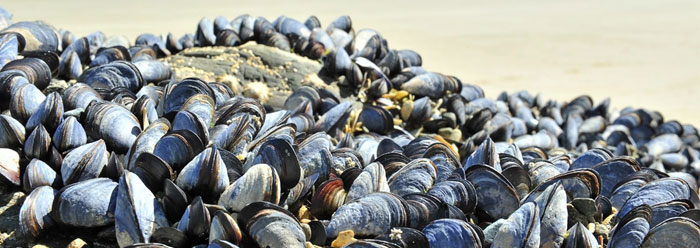Many clams glue themselves onto a solid surface like a rock or coral reef to keep from being tossed about by the surf. The "glue" sets when wet and is extremely strong, partly because tiny fibers enable the glue to self-heal. Similarly, scientists have discovered that a form of bacteria produces an amazingly water-repellent substance called biofilm that "greatly surpass[es] the repellency of Teflon."1
If man-made materials similar to this clam adhesive and biofilm could be produced, they would have wide-ranging applications. And that's exactly what some scientists have been attempting.
Researchers investigated the super-strong glue bond of mussels, a type of clam that inhabits turbulent intertidal zones. They found that the glue works so well because it has structures at the molecular level that form bonds with iron atoms. Unlike covalent bonds, which require specified chemistry for them to reform after they're broken, these bonds between metal and molecule spontaneously reform after they break. This way, the mussels' glue resets between one crashing wave and the next, keeping them securely in place.
The glue doesn't set while it is being manufactured inside specialized glandsóa situation that would cause a lethal messóbecause it sets when its level of acidity changes. In other words, it is produced in acid within the gland, then sets rapidly when exposed to the more alkaline seawater.
The researchers were able to make a similar glue "by mimicking the proposed cross-linking strategy that the mussel employs."2 But the methods they used read like a complicated recipe that requires days to follow. They also used an array of specific chemicals and a host of specialized environments and purification mechanisms. And after all that, their glue only approached the strength of the mussels' self-healing glue when it was in a solution far more alkaline than seawater. Somehow, clams still make better glue, and much more easily.
A separate team investigated the gelatinous biofilm secreted by the beneficial soil and lab-use bacteria Bacillus subtilis. These bacteria are known to live within biofilm, so they are protected from environmental factors, including antibiotics. After investigating the microstructure of biofilm, the study authors made "the surprising observation" that the polysaccharide-based material sheds water, ethanol, and "other organic solvents and commercial biocides" better than any other substance they know.1
The researchers devised a resin with a microscopic surface that had tiny bumps and rills that looked similar to those of biofilm. But when they tested their resin for water repellency, it didn't perform nearly as well as the bacterial biofilm. They concluded that the biofilm's success is not due to just a single attribute such as surface texture. Instead, it is "a synergistic result of" the chemicals that it is made of, the microscopic and nanoscopic 3-D surfaces, "and possibly yet other factors."1 The authors wrote:
As a resilient, environmentally adaptive repellent surface composed of only nontoxic biomolecules, B. subtilis biofilm holds promise as a model surface that can open new directions in antiwetting applications.1
In other words, at this point, manufacturing a substance as water-repellent and environmentally friendly as bacterial biofilm is a distant but compelling dream.
Neither the best glue nor the best water-repellent substances are invented by humans, but are instead found in the created living world. These superior substances are reminders of the genius of their creative Engineer. http://www.icr.org/article/scientists-try-duplicate-clam-glue/
References
- Epstein, A. K. et al. 2011. Bacterial biofilm shows persistent resistance to liquid wetting and gas penetration. Proceedings of the National Academy of Sciences. 108 (3): 995-1000.
- Holten-Andersen, N. et al. pH-induced metal-ligand cross-links inspired by mussel yield self-healing polymer networks with near-covalent elastic moduli. Proceedings of the National Academy of Sciences. Published online before print January 28, 2011, accessed February 2, 2011.
* Mr. Thomas is Science Writer at the Institute for Creation Research.
